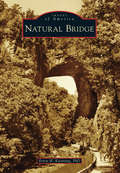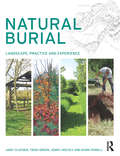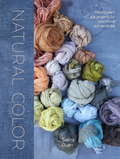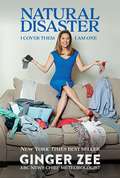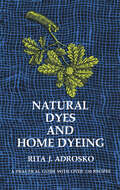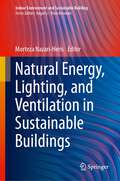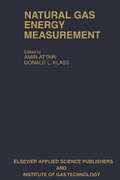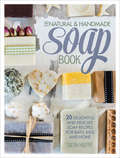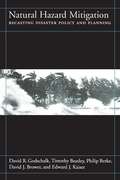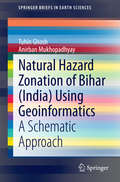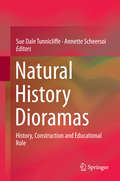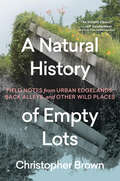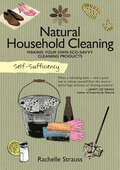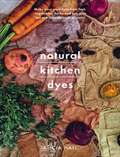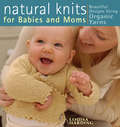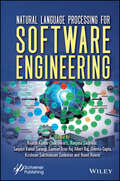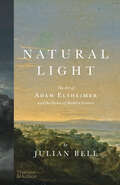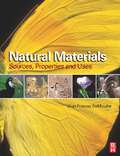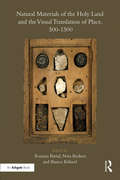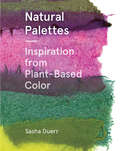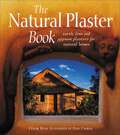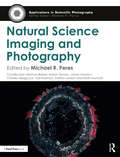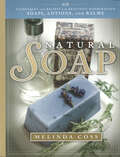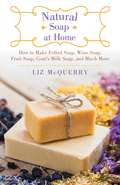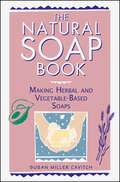- Table View
- List View
Natural Bridge (Images of America)
by Ernst H. KastningNatural Bridge, located in the historic Shenandoah Valley, is one of the most recognized and visited geologic landmarks in the country. The massive 90-foot-wide arch spans Cedar Creek, which runs 200 feet below. Legend says that George Washington, as a young land surveyor, carved his initials on its wall. In 1774, King George III granted ownership to Thomas Jefferson. Natural Bridge was often regarded as the "Eighth Natural Wonder of the World" during the 19th and 20th centuries. The site became a popular venue for events, ranging from conventions to the annual Easter Sunrise Service. Hotels, inns, and cottages were built to accommodate travelers, and on-site attractions--including a show cave, a wax museum, and a Monacan Indian village--broadened visitor appeal. Natural Bridge remained privately owned until 2014, when the title was transferred, allowing it to become a state park; the bridge will now truly belong to the people, a concept that would have made Jefferson proud.
Natural Burial: Landscape, Practice and Experience
by Andy Clayden Trish Green Jenny Hockey Mark PowellThis book unravels the many different experiences, meanings and realities of natural burial. Twenty years after the first natural burial ground opened there is an opportunity to reflect on how a concept for a very different approach to caring for our dead has become a reality: new providers, new landscapes and a hybrid of new and traditional rituals. In this short time the natural burial movement has flourished. In the UK there are more than 200 sites, and the concept has travelled to North America, Holland, Australia, New Zealand and Japan. This survey of natural burials draws on interviews with those involved in the natural burial process – including burial ground managers, celebrants, priests, bereaved family, funeral directors – providing a variety of viewpoints on the concept as a philosophy and landscape practice. Site surveys, design plans and case studies illustrate the challenges involved in creating a natural burial site, and a key longitudinal case study of a single site investigates the evolving nature of the practice. Natural Burial is the first book on this subject to bring together all the groups and individuals involved in the practice, explaining the facts behind this type of burial and exploring a topic which is attracting significant media interest and an upsurge of sites internationally.
Natural Color: Vibrant Plant Dye Projects for Your Home and Wardrobe
by Sasha DuerrA beautiful book of seasonal projects for using the brilliant spectrum of colors derived from plants to naturally dye your clothing and home textiles.Organized by season, Natural Color is a beautifully photographed guide to the full range of plant dyes available, drawn from commonly found fruits, flowers, trees, and herbs, with accompanying projects. Using sustainable methods and artisanal techniques, designer, artist, and professor Sasha Duerr details achievable ways to apply these limitless color possibilties to your home and wardrobe. Whether you are new to dyeing or more practiced, Duerr's clear and simple ingredients lists, step-by-step instructions, and detailed breakouts on techniques such as shibori, dip-dye, and block printing will ensure beautiful results. With recipes to dye everything from dresses and sweaters to rugs and napkins, Natural Color will inspire fashion enthusiasts, home decorators, textile lovers, and everyone else who wants to bring more color into their life. From the Hardcover edition.
Natural Disaster: I Cover them. I am one.
by Ginger ZeeGinger grew up in small-town Michigan where she developed an obsession with weather as a young girl. Ginger opens up about her lifelong battle with crippling depression, her romances that range from misguided to dangerous, and her tumultuous professional path.
Natural Dyes and Home Dyeing
by Rita J. AdroskoHere in a single volume is all the information you will need to extract dyestuffs from common trees, flowers, lichens, and weeds -- all the information you need to create beautifully dyed materials after your own fancy, distinctive and individual. The heart of this book is fifty-two recipes for dyes made from natural, easily obtained dyestuffs: brown dyes from the bark of apple, birch, hemlock, hickory, and maple trees; yellows from a wide variety of sources such as arsemart, white ash bark, barberry bark, sassafras, lichens, camomile flowers, and coffee beans; reds from madder, cochineal, Brazilwood, and alkanet; blues from woad, chemic, orchil and cudbear, as well as from the popular indigo; and blacks most commonly made from logwood and soot. There is also the possibility of combining any of these by top-dyeing (successive dyeing) -- instructions for which are given.Each recipe gives you step-by-step instructions that tell you how to prepare your ingredients, how to shred, soak, dissolve, and boil the materials you collect, how to prepare your cloth (whether cotton or wood) for dyeing, and exactly how long to boil it for optimum results.Besides the fifty-two recipes, most of which are given in several versions, Miss Adrosko deepens your knowledge of dyeing techniques with a history of the craft before the discovery of America, among the colonists, and after 1850 when synthetic dyes began to be used. Appendixes list dyes mentioned in early dyers' manuals printed in America, and give excerpts from three 19th-century treatises which reveal literally hundreds of sources for natural dyestuffs. Concisely written, well organized, this book will not only let you make all the dyes described in its pages, but will also give you the skills to make your own exciting discoveries in a field that has long been neglected.
Natural Energy, Lighting, and Ventilation in Sustainable Buildings (Indoor Environment and Sustainable Building)
by Morteza Nazari-HerisThis book explores the theoretical background and provides an experimental analysis of using natural energy resources in sustainable building design. It brings together an international group of contributors focusing on ways natural energy, lighting, and ventilation can improve the performance of electrical, lighting, and mechanical systems. Contributions explore how natural resources can contribute to sustainable development goals while meeting energy demands and maintaining acceptable interior air quality and natural illumination needs. Coverage includes green building design, renewable energy integration, photovoltaic systems, small-scale wind turbines, natural lighting, and natural ventilation. Natural Energy, Lighting, and Ventilation in Sustainable Buildings offers practical and promising solutions for novel challenges in sustainable design for electrical engineers, energy engineers, architectural engineers, and related professionals, as well as researchers and developers from engineering science.
Natural Gas Energy Measurement
by Amir Attari Donald L. KlassPapers presented at the First and Second IGT Symposium, Chicago, IL, USA, 26-28 August 1985 and 30 April-2 May 1986.
The Natural & Handmade Soap Book: 20 Delightful and Delicate Soap Recipes for Bath, Kids and Home
by Sarah Harper&“The natural products you can make from this book are not only kinder to your skin; they are also better for the planet&” (Soap Making Magazine, &“Top 6 Books for Soap Making&”). From nourishing oat soap bars to impressive rosebud soap cakes and fun soaps for kids, this book will inspire you to make beautiful handmade soap without all the chemicals found in commercial products. Sarah shows you how to master the two key techniques of handmade soapmaking—the traditional cold-process method and the fast and fun melt-and-pour method—and then demonstrates how to use these techniques to make fabulous soaps, shampoo bars, homemade washing powder, and even dishwasher soap bombs. Step-by-step photography and the author&’s insightful advice from years of experience teaching soapmaking makes every project achievable, guiding you effortlessly from start to finish. Packed with handy tips and an easy, approachable style, this is a beautiful book filled with practical projects so that anyone, including children, can make a variety of soaps they will be proud to use, display, and give away! &“This book shows that making soap is not just about the science, but can be another kind of art as it allows makers to bring out their creativity in the process.&” —Bangkok Post &“A fabulous book for anyone interested in all things soap.&” —Sustainable(ish)
Natural Hazard Mitigation: Recasting Disaster Policy And Planning
by David Brower Timothy Beatley Philip Berke Edward J. Kaiser David GodschalkThe first half of the 1990s saw the largest and most costly floods, hurricanes, and earthquakes in the history of the United States. While natural hazards cannot be prevented, their human impacts can be greatly reduced through advance action that mitigates risks and reduces vulnerability.Natural Hazard Mitigation describes and analyzes the way that hazard mitigation has been carried out in the U.S. under our national disaster law, the Robert T. Stafford Disaster Relief and Emergency Assistance Act. It is the first systematic study of the complete intergovernmental system for natural hazard mitigation, including its major elements and the linkages among them.The book: analyzes the effectiveness of the Stafford Act and investigates what is contained in state hazard mitigation plans required by the Act studies how federal hazard mitigation funds have been spent explores what goes into decision making following a major disaster looks at how government mitigation officials rate the effectiveness of the mitigation system suggests changes that could help solve the widely recognized problems with current methods of coping with disasters.Damages from natural disasters are reaching catastrophic proportions, making natural hazard mitigation an important national policy issue. The findings and recommendations presented in this volume should help to strengthen natural hazard mitigation policy and practice, thereby serving to reduce drains on the federal treasury that pay for preventable recovery and relief costs, and to spare residents in areas hit by natural disasters undue suffering and expense. It is an informative and eye-opening study for planners, policymakers, students of planning and geography, and professionals working for government agencies that deal with natural hazards.
Natural Hazard Zonation of Bihar (India) Using Geoinformatics
by Tuhin Ghosh Anirban MukhopadhyayWith increased climate variability, aggravated natural hazards in the form of extreme events are affecting the lives and livelihoods of many people. This work serves as a basis for formulating a 'preparedness plan' to ensure the effective policy formulation for planned development. Increased demand and competition with a high degree of variability have forced people to struggle in order to prosper. Good governance and innovative policy formulation are necessary to create a resilient society. This may promote a paradigm shift in the mindset on and perceptions of natural hazards and their impacts on development and growth. This new perspective will make people more concerned about minimizing the loss of life, property, and environmental damage and directly safeguard the development process. This book presents a detailed methodological approach to monitoring meteorological, hydrological, and climate change aspects to help resolve issues related to our environment, resources, and economies in the changing climate situation.
Natural History Dioramas
by Sue Dale Tunnicliffe Annette ScheersoiThis book brings together in a unique perspective aspects of natural history dioramas, their history, construction and rationale, interpretation and educational importance, from a number of different countries, from the west coast of the USA, across Europe to China. It describes the journey of dioramas from their inception through development to visions of their future. A complementary journey is that of visitors and their individual sense making and construction of their understanding from their own starting points, often interacting with others (e. g. teachers, peers, parents) as well as media (e. g. labels). Dioramas have been, hitherto, a rather neglected area of museum exhibits but a renaissance is beginning for them and their educational importance in contributing to people's understanding of the natural world. This volume showcases how dioramas can reach a wide audience and increase access to biological knowledge.
A Natural History of Empty Lots: Field Notes from Urban Edgelands, Back Alleys, and Other Wild Places
by Christopher BrownA genre-bending blend of naturalism, memoir, and social manifesto for rewilding the city, the self, and society.A Natural History of Empty Lots is a genre-defying work of nature writing, literary nonfiction, and memoir that explores what happens when nature and the city intersect. During the real estate crash of the late 2000s, Christopher Brown purchased an empty lot in an industrial section of Austin, Texas. The property—abandoned and full of litter and debris—was an unlikely site for a home. Brown had become fascinated with these empty lots around Austin, so-called &“ruined&” spaces once used for agriculture and industry awaiting their redevelopment. He discovered them to be teeming with natural activity, and embarked on a twenty-year project to live in and document such spaces. There, in our most damaged landscapes, he witnessed the remarkable resilience of wild nature, and how we can heal ourselves by healing the Earth. Beautifully written and philosophically hard-hitting, A Natural History of Empty Lots offers a new lens on human disruption and nature, offering a sense of hope among the edgelands.
Natural Household Cleaning: Making Your Own Eco-Savvy Cleaning Products (Self-Sufficiency)
by Rachelle StraussDiscover a safer, greener, less expensive way to keep your house clean with this simple guide to making your own natural products. This friendly book will help you become more self-sufficient while benefiting your health, the environment, and your bank balance. Natural Household Cleaning is packed with easy-to-follow recipes for natural alternatives to common commercial cleaning products—all using harm-free ingredients found in your kitchen cupboard! Lemons, salt, vinegar, baking soda, and club soda are just some of the natural ingredients that can be used to clean the kitchen, bathroom, bedroom, floors, and everything in between. Many of us don&’t realize just how easy it is to make your own cleaning products and achieve truly amazing results. Turn a chore into a pleasure and discover a whole new way to clean!
Natural Kitchen Dyes: Make Your Own Dyes from Fruit, Vegetables, Herbs and Tea, Plus 12 Eco-Friendly Craft Projects (Crafts Ser.)
by Alicia Hall&“Hall digs into kitchen chemistry in this cozy guide to using plants to make dyes . . . This fun collection will be a valuable addition to any DIY library.&” —Publishers Weekly With Natural Kitchen Dyes you can explore the magical world of natural dyes, without the need of a garden full of dye plants. Our kitchens are a great source of natural dye colors, from vegetable peels that create blush pinks and peaches, fruit skins that make lemon yellows, a green dye sourced from carrot tops, dried spices, and used tea bags to create vibrant yellows, rich terracottas, and deep browns. Natural Kitchen Dyes takes you through the exciting process of creating these wonderful natural colors, dyeing fabric with the dyes, and suggests ingenious ways to get your hands on some natural dye sources. Accompanying the natural dye recipes in the book are ten environmentally conscious projects, which have been created not only to show off the natural dyes beautifully, but to help eliminate waste. Several of the projects actually utilise waste that would otherwise be composted or recycled such as old clothes turned into bags and patchwork floor cushions, to dried pulses past their expiration date used to make a beaded necklace. &“This is my sort of book: no need to start your adventure with a shopping expedition for ingredients—at least not to begin with—it&’s all there in the kitchen for a safe, spur-of-the-moment indulgence.&” —The Journal for Weavers, Spinners & Dyers &“Hall outlines a kid-friendly craft that just might engage adults too.&” —Booklist
Natural Knits for Babies and Moms: Beautiful Designs Using Organic Yarns
by Louisa HardingThis inspired collection of patterns for mother and baby includes designs with a simple flare and an elegant, modern feel for use with organically grown, undyed yarns. The projects are designed for beginning to average knitters so that essential baby accessories such as booties, mittens, hats, and simple knitted toys are quickly completed and instantly cherished. A cot blanket is an example of a group project designed to be made in one evening, and slightly more ambitious designs include an adorable dress, a chunky jacket, or a kimono sweater for a baby and wonderful, cozy items for mothers such as an unusual "bump" sweater for pregnant women, nursing sweaters that are convenient and stylish, and herb-scented pillows that delight the eye and soothe the spirit.
Natural Language Processing for Software Engineering
by Rajesh Kumar Chakrawarti Ranjana Sikarwar Sanjaya Kumar Sarangi Samson Arun Raj Albert Raj Shweta Gupta Krishnan Sakthidasan Sankaran Romil RawatDiscover how Natural Language Processing for Software Engineering can transform your understanding of agile development, equipping you with essential tools and insights to enhance software quality and responsiveness in today’s rapidly changing technological landscape. Agile development enhances business responsiveness through continuous software delivery, emphasizing iterative methodologies that produce incremental, usable software. Working software is the main measure of progress, and ongoing customer collaboration is essential. Approaches like Scrum, eXtreme Programming (XP), and Crystal share these principles but differ in focus: Scrum reduces documentation, XP improves software quality and adaptability to changing requirements, and Crystal emphasizes people and interactions while retaining key artifacts. Modifying software systems designed with Object-Oriented Analysis and Design can be costly and time-consuming in rapidly changing environments requiring frequent updates. This book explores how natural language processing can enhance agile methodologies, particularly in requirements engineering. It introduces tools that help developers create, organize, and update documentation throughout the agile project process.
Natural Light: The Art Of Adam Elsheimer And The Dawn Of Modern Science
by Julian BellA brand-new perspective on early modern art and its relationship with nature as reflected in this moving account of overlooked artistic genius Adam Elsheimer, by an outstanding writer and critic. Seventeenth-century Europe swirled with conjectures and debates over what was real and what constituted “nature,” currents that would soon gather force to form modern science. Natural Light deliberates on the era’s uncertainties, as distilled in the work of long underappreciated artist Adam Elsheimer (1578–1610), a native of Frankfurt who settled in Rome and whose diminutive and mysterious narrative compositions related figures to landscape in new ways, projecting unfamiliar visions of space at a time when Caravaggio was polarizing audiences with his radical altarpieces and early modern scientists were starting to turn to the new “world system” of Galileo. His visual inventions influenced many famous artists—including Rembrandt van Rijn, Claude Lorrain, and Nicolas Poussin. Julian Bell guides the reader through key Elsheimer artworks, examining the contexts behind them before exploring the new imaginative thoughts that opened up in their wake. He also explores the experiences of Elsheimer and other Northern artists in the literary, artistic, and scientific culture of 1600s Rome. Although his life was tragically short, Elsheimer’s legacy endured and prints of his work were widely spread throughout Europe, with his influence extending as far as the Indian subcontinent.
Natural Materials
by Jean DeMoutheMost museums collections contain a wide variety of natural materials, and a diverse range of knowledge is necessary to keep so many types of objects at their best. This book studies the composition, structure and properties of natural materials such as wood, paper, amber, coral and feathers, and discusses the potential hazards they face, as well as the appropriate conservation techniques to use for each. Providing plenty of detail in an easily accessible format, Natural Materials is a useful resource for students, professionals and collectors alike.
Natural Materials of the Holy Land and the Visual Translation of Place, 500-1500
by Renana Bartal Neta Bodner Bianca KuhnelNatural Materials of the Holy Land and the Visual Translation of Place, 500-1500, focuses on the unique ways that natural materials carry the spirit of place. Since early Christianity, wood, earth, water and stone were taken from loca sancta to signify them elsewhere. Academic discourse has indiscriminately grouped material tokens from holy places and their containers with architectural and topographical emulations, two-dimensional images and bodily relics. However, unlike textual or visual representations, natural materials do not describe or interpret the Holy Land; they are part of it. Tangible and timeless, they realize the meaning of their place of origin in new locations. What makes earth, stones or bottled water transported from holy sites sacred? How do they become pars pro toto, signifying the whole from which they were taken? This book will examine natural media used for translating loca sancta, the processes of their sanctification and how, although inherently abstract, they become charged with meaning. It will address their metamorphosis, natural or induced; how they change the environment to which they are transported; their capacity to translate a static and distant site elsewhere; the effect of their relocation on users/viewers; and how their containers and staging are used to communicate their substance.
Natural Palettes: Inspirational Plant-Based Color Systems
by Sasha Duerr“The plant-lover’s alternative to the Pantone color guide.”—Julia Sherman, creator of Salad for President Renowned natural dyer, artist, and educator Sasha Duerr envisions a new age of fresh, modern color palettes, drawing from our original source of inspiration and ingredients—the natural world around us. This innovative plant-based color guide includes twenty-five palettes with five hundred natural color swatches, providing a bounty of ideas for sustainable fashion, textiles, fine art, floral design, food, medicine, gardening, interior design, and other creative disciplines. Bring the healing power of forest bathing into your home with a palette of spruce cones, pine needles, and balsam branches. Move past Pantone and embrace the natural balance of a pollinator palette with Hopi sunflower, red poppy, echinacea, and scabiosa.Duerr complements her palettes with illuminating reflections on connections between color and landscape, the healing properties of medicinal plants, the ways food and floral waste can be regenerated to enhance lifestyle experiences, the ecological benefits of using natural colors, and more. You may never view color—or the plants that surround us—the same way again.
The Natural Plaster Book: Earth, Lime and Gypsum Plasters for Natural Homes
by Cedar Rose Guelberth Dan ChirasFor builders of natural homes (straw bale, cob, adobe, rammed earth, and other natural materials), this unique step-by-step guide takes the confusion out of choosing, mixing, and applying natural plasters.From principles to practicalities, and with every stage of the process illustrated, The Natural Plasters Book details the entire process of plastering with earth, lime, and gypsum for a long-lasting and durable finish. Starting with an overview and history of the natural building movement, the book handles a wide variety of topics including earthen plaster versus cement stucco, tools and techniques of the trade, plaster recipes, and pigmenting plaster or painting walls with natural paints. First-time builders will appreciate tips on common mistakes (and how to avoid them) discussed at each stage of the plastering process. Special focus is paid to the importance of planning and designing for earthen plasters- before building begins.The only comprehensive guide available on natural plasters, this book is written for the growing number of people who have decided to build their own natural homes as well as for professionals. Heavily illustrated with practical drawings and photographs, it also includes an extensive resource guide listing books, magazines, videos, builders, and suppliers.
Natural Science Imaging and Photography (Applications in Scientific Photography)
by Michael R. PeresThis book provides an in-depth exploration of scientific photography. Highlighting the best practices needed to make, distribute, and preserve scientific visual information using digital photographic methods and technologies, it offers solutions to some of the biggest challenges facing photographers. Written by a team of international, award-winning image makers with over 300 years of cumulative experience, this comprehensive resource explains the foundations used, the tools required, and the steps to needed for creating the optimal photograph in a range of environments and circumstances. Topics covered include: • ethical practices • aerial photography • close-up and macro photography • computational photography • field photography • geological photography • imaging with invisible spectrums • photographing small animals in captivity • time-based imaging • image processing in science Showcasing modern methods, this book equips readers with the skills needed to capture and process the best image possible. Designed for basic and intermediate photographers, Natural Science Imaging and Photography exists as an essential contemporary handbook.
Natural Soap: Techniques and Recipes for Beautiful Handcrafted Soaps, Lotions and Balms
by Melinda CossLearn how to make natural soaps that are beautiful, luxurious, and kind to your skin with this comprehensive guide by the master soap maker.In Natural Soap, Melinda Coss focuses on natural ingredients and provides a wonderful range of recipes for bar and liquid soaps as well as creams, lotions, and balms. With clear, accessible instructions, she covers all the techniques and equipment you will need to get started making these wonderful soaps. The recipes include fruits soaps. scrub bars, skin creams, flower waters, and much more. There’s even a section on special effects for a real treat. Melinda also includes essential advice on starting your own soap making business for anyone looking to profit from their newfound skills.
Natural Soap at Home: How to Make Felted Soap, Wine Soap, Fruit Soap, Goat's Milk Soap, and Much More
by Liz McQuerryThe creator of the natural skin care line Moon Magic, Liz McQuerry offers here a step-by-step guide for natural cold-process soap crafting. Mostly utilizing kitchen ingredients to create a variety of innovative soap blends—including felted soap, beer soap, and seasonal soaps—McQuerry will put you in touch with your inner alchemist. From body bars to hair care bars, with wonderful tidbits and advice on herbs and essential oil blends, you and your family will enjoy a clean like never before. Here are instructions for:Mermaid Kisses Salty Sea SoapGolden Coconut Milk SoapWine and Rose SoapFelted Soap StonesRefreshing Lemon Solid Shampoo BarsBeard Wash Solid Soap BarsAnd more!After you learn to make your own soap, you’ll also discover how to scent, color, design, troubleshoot, and even sell your soap. McQuerry’s soaps make for attractive and personal bathroom and kitchen décor at home, as well as nifty gifts for just about any occasion.
The Natural Soap Book: Making Herbal and Vegetable-Based Soaps
by Susan Miller CavitchMaking your own soap is fun, easy, and rewarding. In this introductory guide, Susan Miller Cavitch shows you how to craft your own all-natural, wonderfully smelling soaps. Illustrated directions take you through the whole process, from buying supplies to cutting the final bars. With easy-to-follow recipes that range from classics like oatmeal and honey soap to more adventurous combinations using goat milk and borage, you’ll be inspired to make uniquely personal soaps that are gentle on your skin and a pleasure for your nose.
